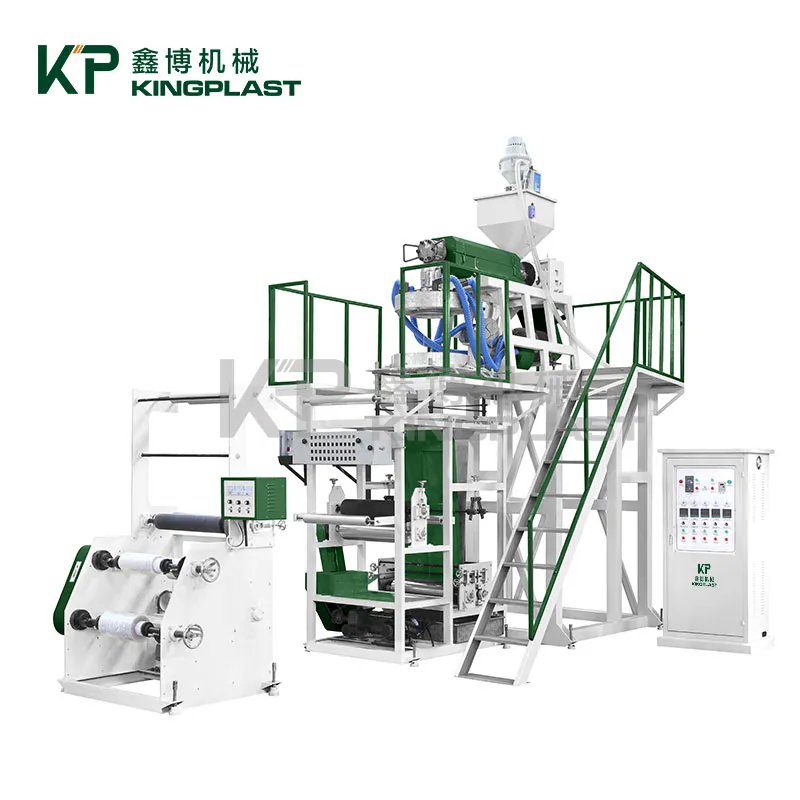Types of Film Blowing Machines
2024-08-14
A Film Blowing Machine is a piece of industrial equipment used to manufacture plastic films by blowing molten plastic into thin, continuous sheets. These machines are commonly used in the production of packaging materials, such as plastic bags, wraps, and various types of protective films. The process involves extruding molten plastic through a die and then blowing air into it to form a thin, tubular film.
Key Components and Functions:
1. Extruder:
- Function: Melts and extrudes plastic pellets into a molten form. The extruder consists of a barrel and a screw, which mix and push the plastic towards the die.
- Types: Single-screw extruders (most common) and twin-screw extruders (for more complex processes).
2. Die:
- Function: Shapes the molten plastic into a tubular form as it exits the extruder. The die determines the film’s diameter and thickness.
- Types: Flat dies (for producing flat films) and annular dies (for producing tubular films).
3. Blowing System:
- Function: Introduces air into the molten plastic tube to expand it into a thin film. The blowing system includes an air ring and a fan to control the air flow and film expansion.
- Components: Air ring, cooling rings, and sometimes a blower or fan.
4. Cooling System:
- Function: Cools the expanded film to solidify the plastic. The cooling system usually involves a series of air rings or water baths.
- Components: Air rings, water baths, and sometimes cooling rollers.
5. Take-Up System:
- Function: Collects and winds the finished film onto rolls. This system often includes a set of rollers that guide the film onto a spool.
- Components: Winding rollers, tension controls, and film guides.
6. Control Panel:
- Function: Manages the operation of the machine, including temperature control, extrusion speed, and film thickness.
- Components: Digital displays, control buttons, and programmable logic controllers (PLCs).
Film Blowing Process:
1. Material Feeding:
- Plastic pellets are fed into the extruder, where they are heated and melted.
2. Extrusion:
- The molten plastic is pushed through the die, forming a thin, tubular film.
3. Blowing:
- Air is blown into the tubular film to expand it to the desired thickness and diameter. The film is then cooled to solidify the plastic.
4. Cooling:
- The expanded film is cooled using air or water to set its shape and thickness.
5. Winding:
- The finished film is collected and wound onto rolls for further processing or packaging.
Types of Film Blowing Machines:
1. Single-Layer Film Blowing Machine:
- Description: Produces a single layer of film. Used for simpler applications where only one type of plastic is needed.
- Applications: Basic packaging films, garbage bags.
2. Multi-Layer Film Blowing Machine:
- Description: Produces films with multiple layers, allowing for different types of plastic to be used in each layer. Provides enhanced properties such as strength, barrier protection, and flexibility.
- Applications: Advanced packaging materials, barrier films, laminates.
3. Stretch Film Blowing Machine:
- Description: Produces stretchable films used for wrapping and securing products. The process involves stretching the film to improve its strength and elasticity.
- Applications: Stretch wraps, pallet covers.
4. Micro-Perforated Film Blowing Machine:
- Description: Produces films with small perforations to allow air and moisture to pass through. Used for applications requiring breathability.
- Applications: Fresh produce bags, breathable packaging.
Applications:
1. Packaging:
- Used to produce films for packaging various products, including food, pharmaceuticals, and consumer goods.
2. Agricultural Films:
- Produces films for greenhouse covers, mulch films, and other agricultural applications.
3. Industrial Applications:
- Used for manufacturing protective films, liners, and other industrial materials.
4. Medical and Hygiene Products:
- Produces films for medical packaging, disposable products, and hygiene items.
Advantages:
- Versatility: Capable of producing a wide range of film types and thicknesses.
- Efficiency: High production rates and continuous film production.
- Cost-Effective: Produces films with minimal waste and high material efficiency.
- Customizability: Ability to produce films with different properties and multi-layer structures.
Example of Usage:
- In a Packaging Facility: A film blowing machine produces plastic wrap used to package food products. The machine extrudes molten plastic through a die, blows it into a thin film, and then cools and winds the film onto rolls for use in packaging.
Film Blowing Machines are essential in the production of various plastic films, providing a versatile and efficient means of creating packaging and protective materials for a wide range of applications.



